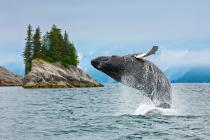Whale Watching: Juneau’s Favorite Pastime
What intrigues you most about Alaska? For many, a sense of adventure is what beckons them to the coast of America’s last frontier. Visitors love panning for gold in old mining towns and gazing at towering totem poles. But passengers on our Christian cruises to Alaska often find the state’s most fascinating feature isn’t found in its iconic landscape, but in the icy waters that border it.
The humpback whale is one of the best-known residents of the Pacific Ocean, and summers in Juneau are perfect for experiencing these magnificent creatures in their natural habitat. By this time in the year, the whales have migrated some 3,000 miles to feed and rejuvenate in its protected waters.
What to Expect when you’re Whale Watching
These friendly, even playful animals serve as a sort of welcoming committee for the state. More often than not, you’ll encounter a whale who likes the limelight and starts showing off for his guests. Along with fin slapping and lobtailing, special moments include observing the whales feed and seeing baby calves drink milk from their mothers. A recent study from the University of Southeast Alaska found that whales have gradually become accustomed to boat traffic, including the presence of whale watchers. (For a firsthand account of a Juneau whale watch, click here.)
Many other marine species also call coastal Alaska home. Harbor seals are plentiful, as are orange-beaked puffins. Sea otters and porpoises abound in the open water. And the fact that Juneau boasts one of the highest concentrations of bald eagles in North America virtually guarantees several of these stately birds will be soaring overhead. You can look forward to glimpsing any number of these furry, feathered or fearsome animals on a whale watch, but of course, the stars of the show are the whales themselves.
Then & Now
As beloved as whale watching has become, it’s still a relatively new phenomenon. The attraction developed in the mid-twentieth century off the West Coast near San Diego, just as leisure cruising gained in popularity. In fact, 2017 is the seventieth year that our partner, Holland America Line, has been taking cruisers through the fjords and ports of Alaska.
With interest in the activity skyrocketing, providers have honed their craft with faster and faster vessels to deliver an optimal experience for guests. Jet boats and catamarans are equipped with sophisticated radar technology to locate the whales. And they have plenty of deck space for viewing, along with enclosed, heated cabins to keep participants warm along the way. Expert guides and naturalists are always onboard to educate travelers about the rare phenomena they’re witnessing.
While it’s possible to see whales aboard a cruiseliner, the mammals are usually too far away to observe in detail. This doesn’t stop people from bringing binoculars (or using the pair complementary within every Holland America suite) to make out distant shapes or waterspouts that break the horizon. But these sightings lack the “wow” factor of a close encounter of the whale kind. That’s why most travelers book an excursion on a much smaller seacraft. These allow captains the maneuverability to take participants within close range of a whale pod.
Are you ready to encounter a majestic creature of the deep? Join us on one of our upcoming Alaska cruises and book an excursion with your cruise line or with our partners at Juneau Whale Watch to experience these graceful giants.






